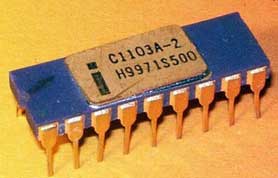
Key Points about Dynamic Random Access Memory
- Robert Dennard invented dynamic Random Access Memory in 1966 at IBM.
- Dynamic Random Access Memory is dynamic (or active) because it must be refreshed regularly, or the data stored in it will be lost.
- The most common type of RAM is dynamic random access memory (DRAM).
- DRAM as the computer’s main memory is one of its most common applications.
- Every DRAM memory cell is composed of a transistor and a capacitor, with the capacitor storing a data bit.
Dynamic Random Access Memory: History
Robert Dennard invented Dynamic Random Access Memory-DRAM, which is now one of the most important developments in computer technology. The one-transistor Dynamic Random Access Memory (DRAM) created by Robert Dennard allowed significant advances in computer memory density while also lowering costs. In addition, it established the industry benchmark for RAM and paved the microcomputer revolution.

Dennard was born in Terrell, Texas, in the United States. In 1954 and 1956, he got his B.S. and M.S. degrees in Electrical Engineering from Southern Methodist University in Dallas. In 1958, he received his doctorate from the Carnegie Institute of Technology in Pittsburgh, Pennsylvania. Dennard also joined IBM’s Research Division as a Staff Engineer in 1958, intending to understand the industry for a couple of years at most. Instead, Robert Dennard is still one of IBM’s most prestigious engineers 42 years later.
Quick Facts
- Created
- 1967
- Creator (person)
- Robert Heath Dennard
- Original Use
- DRAM is one type of RAM found in modern desktops and laptops.
- Cost
- $4
Dennard led a small research team at IBM that worked on field-effect transistors (FETs) and integrated circuits, with each bit of data stored in a six-transistor memory cell. Dennard proposed in 1966 that binary data be stored on a capacitor as a positive or negative charge. The only problem was that capacitors leak charge in milliseconds, so after months of testing, Dennard invented a setup in which each bit of information would be handled by a single transistor, drastically lowering the size of the entire cell.
RAM was a well-known and widely utilized notion: temporary memory for writing to and reading from that would be deleted when the person switched the machine off. However, RAM required a complex system of wires & magnets that were bulky and power-demanding in the mid-1960s, offsetting RAM’s theoretical efficiency in practice. Dennard’s breakthrough achievement was to condense RAM to a single-transistor memory cell. Dennard’s idea resulted in modern computers being able to carry a billion or more RAM cells on a single chip.
In 1965, a Toshiba calculator used a capacitive type of DRAM manufactured from bipolar memory cells as one of the early uses of DRAM. However, the bipolar DRAM in use at the time couldn’t compete with magnetic-core memory. Bipolar transistors were utilized in the earliest types of DRAM mentioned above. While bipolar DRAM outperformed magnetic-core memory in terms of performance, it couldn’t compete with magnetic-core memory’s lower pricing.
Dynamic Random Access Memory: How It Worked
DRAM, invented by IBM’s Robert Dennard in 1966, is unlike any other type of memory. DRAM’s primary storage cell comprises two components: a transistor and a capacitor.
The transistor is used to charge or discharge the capacitor when a bit needs to be stored in memory. The logic high, or ‘1’, is represented by a charged capacitor, while the logic low, or ‘0,’ is represented by a discharged capacitor. The wordline and bitline are used for charging and discharging.
The word line goes high during reading or writing, and the transistor connects the capacitor to the bitline. The capacitor stores or retrieves whatever value is on the bitline (‘1’ or ‘0’).
Because the charge stored on each capacitor is too small to be read directly, a circuit called a sense amplifier is used to measure it. The sense amplifier detects minute charge differences and outputs the appropriate logic level. Unfortunately, reading from the bitline causes the charge in the capacitor to flow out. As a result, reads in DRAM are destructive. To get around this, the value read from the bitline is re-entered into the capacitor via a process known as precharging.
Dynamic Random Access Memory: Historical Significance
Dennard was granted a patent for his Field-effect Transistor Memory in June 1968 (see the US patent 3387286).

In 1970, the newly formed Intel company publicly released the 1103 (see the nearby image), the first DRAM chip (1 Kbit PMOS dynamic RAM ICs), and by 1972 it was the best-selling semiconductor memory chip in the world, defeating magnetic core type memory. The first commercially available computer using the 1103 was the HP 9800 series.
Dennard’s DRAM was standard in practically all computers by the mid-1970s. When personal computers first became a possibility, the RAM system enabled them to conduct complicated functions while still fitting on a desktop. The new type of DRAM could read current data while accessing further information from a computer’s hard drive, allowing it to multitask.

